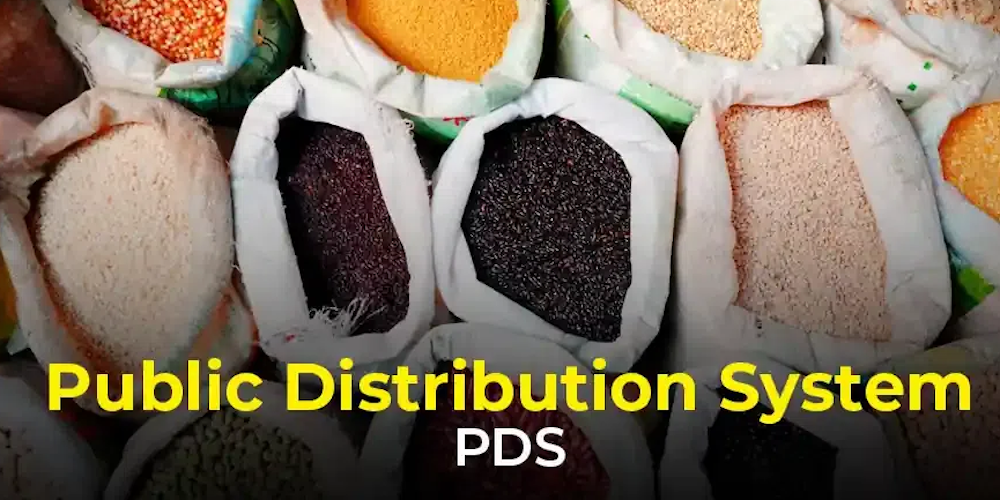Issues Relating to Development and Management of Social Sector/Services relating to Health, Education, Human Resources; Issues relating to Poverty and Hunger
Examine how the Public Distribution System (PDS) affects the way people in households spend their money and how it contributes to reducing poverty, based on the results of the Household Consumption Expenditure Survey (HCES) for the 2022-23 period.
As per the National Food Security Act (NFSA), 2013, up to 75% of rural and 50% of urban inhabitants can get subsidized food grains through the PDS. By doing this, households are able to divert their food consumption and free up funds for other necessary expenses.
PDS’s Effect on the Diversification of Household Expenses The question is whether households may allocate more funds to other nutrient-dense foods like vegetables, dairy products, lentils, eggs, and meat because the public distribution system offers subsidized grains. This change to a diet would be extremely important for improving households’ general nutritional health.
Accuracy and Representativeness of HCES Data: Giving accurate estimates of the percentage of households receiving benefits under each scheme is not the survey’s main goal. Errors in inclusion and exclusion are a worry. To accurately determine the breadth and impact of the PDS, one must carefully evaluate the survey estimates and contrast them with administrative data.
Assigning Values to Free Supplies: The National Sample Survey Office (NSSO) has initiated a process to assign monetary values to items like food and non-food given to households at no cost. This procedure aids in calculating two key figures: the Monthly Per Capita Consumption Expenditure (MPCE) and MPCE, which encompasses the worth of items given for free. The valuation is based on market prices, excluding any discounts received from the Public Distribution System (PDS).
Reviewing the Poverty Threshold: This process calls for a re-evaluation of the poverty threshold, questioning whether it should be set on the basis of expenditure or total consumption value, which includes free supplies. Social transfers in kind, such as those offered by the PDS, have significant impacts on the welfare of households at the lower end of the consumption or income scale.
State-Level Variations and Policy Implications: Social welfare programs have differing effects on household spending in different states, necessitating tailored evaluations and strategies. Comprehending these distinctions is crucial in formulating efficacious measures to enhance food security and mitigate poverty.
Way Forward:
Enhancing Targeting Mechanisms: To precisely identify eligible households, employ Aadhaar-based identification and combine multiple databases. By guaranteeing that benefits are only granted to individuals who match the criterion, this can minimize inclusion errors. To cut down on leaks and increase targeting accuracy, states like Tamil Nadu and Andhra Pradesh have effectively used biometric authentication systems.
Food Items’ Diversification in PDS: Add more items high in nutrients, such as edible oils and pulses, to the PDS. This may enhance the general nutritional consumption of households. The addition of pulses and millets in the PDS has been trialed by the Karnataka government, and the recipients have responded well.
Improved Monitoring and Evaluation: To track the distribution and consumption of PDS items, conduct frequent household surveys and audits by outside parties. Use GPS tracking when moving food grains to avoid delivery delays and assure timely delivery.
Community Involvement and Awareness: Run neighborhood-based awareness programs to inform recipients of their rights and the procedure for filing complaints. Transparency and accountability have greatly increased in Andhra Pradesh thanks to the “Social Audit” method, in which community people examine the PDS distribution.
Changes to Policy and Flexibility: Give states additional latitude to modify the PDS to suit local requirements, such as incorporating foods unique to a given area. Improved customisation and efficiency in meeting local needs can result from the PDS’s decentralization and flexibility.
The 2022-23 Household Consumption Expenditure Survey (HCES) provides valuable insights into the impact of the Public Distribution System (PDS) on household spending patterns. By quantifying the value of free food and other non-food assistance, the study reveals that in-kind transfers significantly enhance the total resources available to low-income households. This finding has prompted discussions on the precise assessment of poverty rates.
Reference: https://www.thehindu.com/opinion/op-ed/the-pds-impact-on-household-expenditure/article68397604.ece

